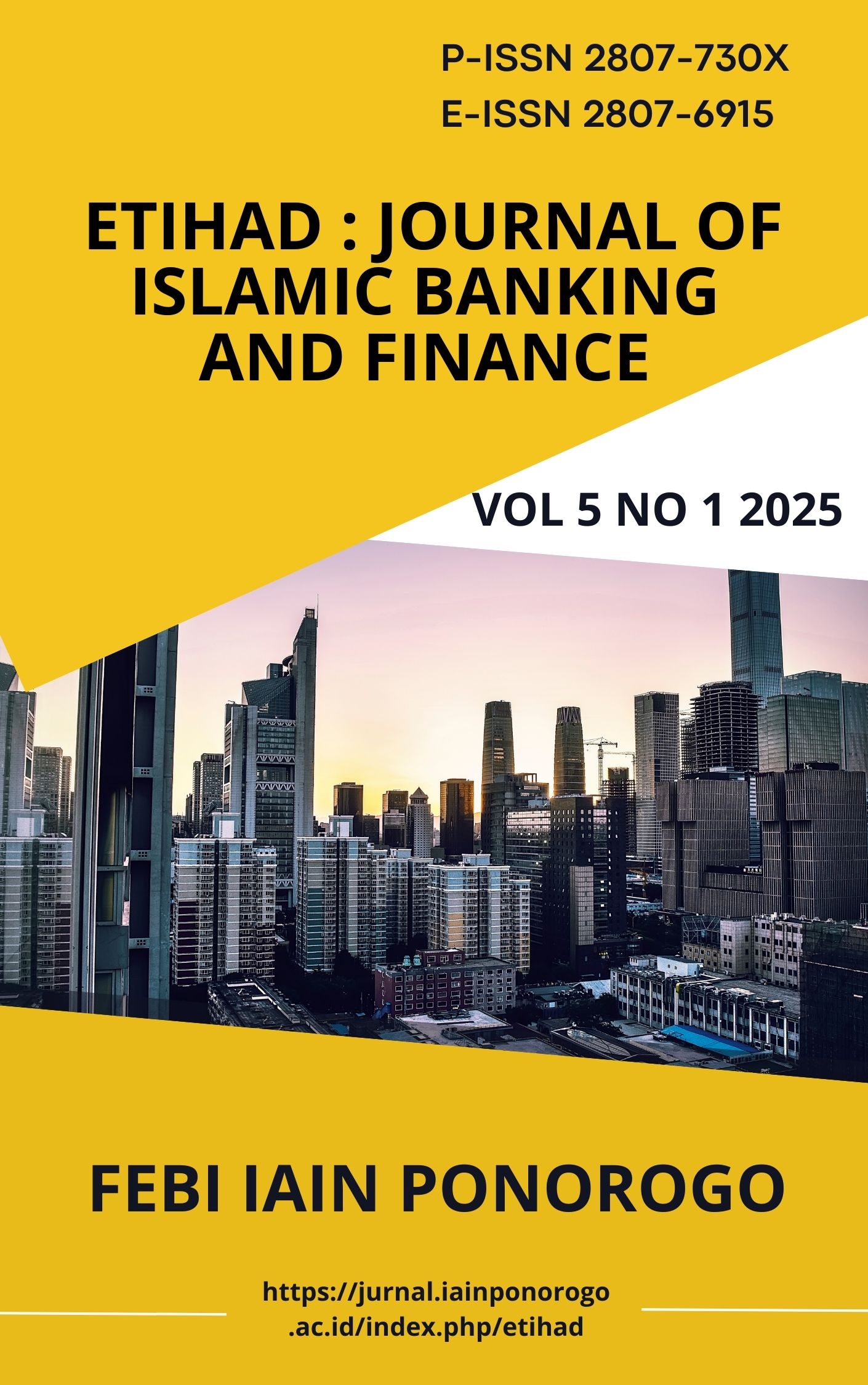The Nicher Market Strategy of BPRS Mitra Mentari in Increasing Financing for MSME Entrepreneurs
DOI:
https://doi.org/10.21154/etihad.v5i1.10721Keywords:
Market Competition Strategy, Financing, MSMEs, Local Islamic BanksAbstract
Introduction: Profit-sharing financing is a key feature of Islamic banks and should be maintained. One example is the Micro Express product, designed for MSMEs, especially small traders. However, BPRS faces strong competition from both conventional banks and informal lenders known as Plecit Banks. This study aims to examine the market share and competitors of the Micro Express at BPRS Mitra Mentari and to develop effective strategies to boost its financing. Research Methods: This research is field research using a qualitative approach with descriptive analysis. Results: As a market follower, BPRS can apply an imitator and adopter strategy by adopting competitor tactics—such as the pick-up service commonly used by Plecit Banks—and enhancing them through culturally unique approaches rooted in local wisdom, offering a distinct value proposition. Conclusion: Maintaining compliance with sharia principles remains essential—not only as a core identity of Islamic banks but also as a sustainable competitive advantage in the face of intense competition.
References
Alshammari, T. (2017). Performance differences between Islamic and conventional bank forms. Banks and Bank Systems, 12(3).
Arikunto, S. (2006). Prosedur penelitian: Suatu pendekatan praktik. Rineka Cipta.
Belkhaouli, S., Alsagr, N., Fan Hemmen, S. F., & Elgammal, M. M. (2020). Financing modes, risk, efficiency and profitability in Islamic banks: Modelling for GCC countries. Cogent Economics & Finance, 8(1).
First, F. S., Mulyono, I., & Jaswadi, J. (2023). Characteristics of customers of Islamic financial institutions in the village of Sukopuro, Jabung District, Malang Regency. European Journal of Accounting, Auditing and Finance Research, 11(1), 1–7. https://doi.org/10.37745/ejaafr.2013/vol11n117
Gulam, M. (2022). Menguak alasan di balik minimnya nasabah pengguna bank syariah di Gorontalo. AKASYAH: Jurnal Akuntansi, Keuangan dan Audit Syariah, 1(1), 39–53. https://doi.org/10.58176/akasyah.v1i1.365
Herliansyah, Y., Nugroho, L., Ardilla, D., & Putra, Y. (2020). The determinants of micro, small and medium entrepreneur (MSME) becoming customers of Islamic banks (religion, religiosity and location of Islamic banks). Proceedings of the 2019 ICEI (pp. — —). https://doi.org/10.4108/eai.26-3-2019.2290775
Irham, M., & Rahma, T. I. F. (2020). Analisis persepsi dosen tamu terhadap perbankan syariah di Universitas Islam Negeri Sumatera Utara. J EBIS, 5(1), 64–65.
Jaffar, M. M., Zain, S. M., & Jemain, A. A. (2017). Diminishing musyarakah investment model based on equity. AIP Conference Proceedings, 1905, Article 020003. https://doi.org/10.1063/1.5012143
Jusoh, M., & Khalid, N. (2019). A model of demand for Islamic banks’ debt based on financial instrument. Jurnal Pengurusan, 39, 31–36.
Khalidi, M. A., & Amanullah. (2011). Consumer perception of Islamic banking in Pakistan. Labuan Bulletin of International Business and Finance, 8, 1–21. https://doi.org/10.51200/lbibf.v8i.2567
Majeed, M. T., & Zaenab, A. (2021). A comparative analysis of financial performance of Islamic banks vis à vis conventional banks: Evidence from Pakistan. ISRA International Journal of Islamic Finance, 13(3), 331–346. https://doi.org/10.1108/IJIF 08 2018 0093
Monferrer, D., Moliner, M. A., & Estrada, M. (2019). Increasing customer loyalty through customer engagement in the retail banking industry. Spanish Journal of Marketing – ESIC, 23(3), 461–484. https://doi.org/10.1108/SJME 07 2019 0042
Putri, P. T., Hadinugroho, B., & Haryanto, B. (2020). Behaviour approach SMEs in utilizing Islamic banks. International Journal of Education and Social Science Research, 3(6), 127–143. https://doi.org/10.37500/ijessr.2020.3610
Ramadhan, S., Selim, M., & Sehwan, A. (2019). Financial performance of conventional and Islamic banks in Bahrain: A comparative study. Banks and Bank Systems, 14(4), — —.
Saifuzzaman, M., & Mahmood, R. (2023). A review of challenges and solutions in use of murabahah products in Islamic banks. International Journal of Research and Innovation in Social Science, 7(7), — —. https://doi.org/10.4772/IJRISS.v7i7.
Samorodov, B., Azarenkova, G., Golovko, O., Oryekhova, K., & Babenko, M. (2019). Financial stability management in banks: Strategy maps. Banks and Bank Systems, 14(4), 10–21. https://doi.org/10.21511/bbs.14(4).2019.02
Sbeiti, W., & Alqatan, A. (2021). Islamic banking performance versus conventional banking. Review of Economic and Finance, 19(1), — —.
Setywati, I., Suroso, S., Suryanto, T., & Nurjanah, D. S. (2017). Does financial performance of Islamic banking is better? Panel data estimation. European Research Studies Journal, 20(24), 532–606.
Soemitro, A. (2009). Bank dan lembaga keuangan syariah [Sharia banks and financial institutions]. Kencana Prenadamedia Group.
Sugiyono. (2013). Metode penelitian kuantitatif, kualitatif, dan R&D. Alfabeta.
Yaseen, Z., & Kamran, S. (2019). Exploring the impediments faced by banking customers to adopt Islamic banking services in Pakistan. Journal of Islamic Business and Management, 9(1), 25–41. https://doi.org/10.26501/jibm/2019.0901 003
Yustiardhi, F. A., Diniyya, A. A., Faiz, A. A., Subri, N. S., & Kurnia, Z. N. (2020). Issues and challenges of the application of mudarabah and musharakah in Islamic bank financing products. Journal of Islamic Finance, 9(2), 26–41.
Downloads
Published
Issue
Section
License
Copyright (c) 2025 Ely Masykuroh, Fibrianis Puspita Anhar, Berlianto Haris

This work is licensed under a Creative Commons Attribution-NonCommercial 4.0 International License.
Etihad: Journal of Islamic Banking and Finance allow the author(s) to hold the copyright without restrictions and allow the author(s) to retain publishing rights without restrictions, also the owner of the commercial rights to the article is the author.







